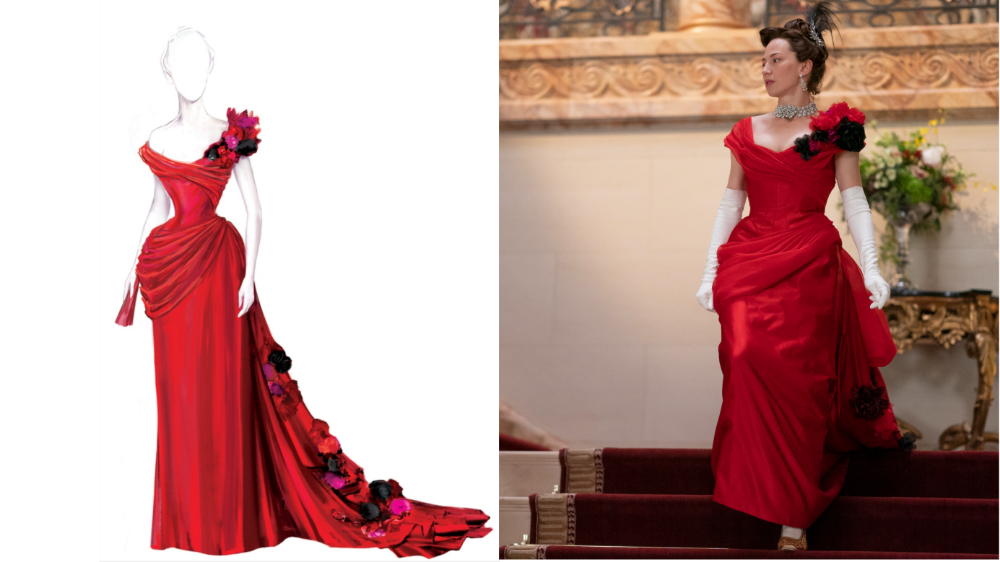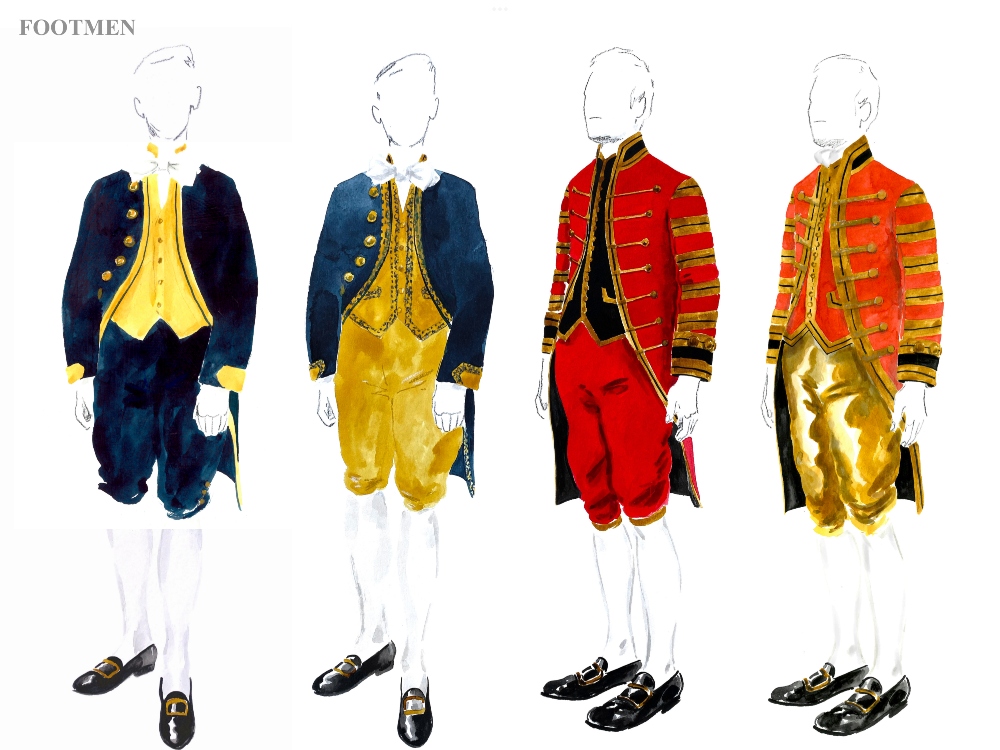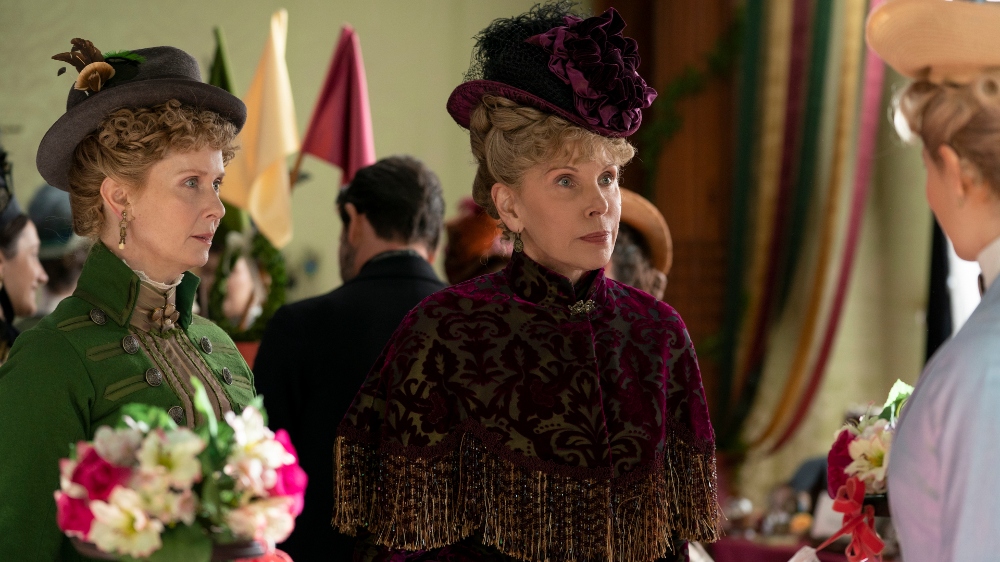
Over two centuries ago, the Gilded Age era was all the rage in New York City with mansions lining the streets and dirt-paved roads providing the way for horses and buggies. It was a time of extreme division between the haves and the have-nots, illustrated by the social society in which the wealthy held extravagant balls orchestrated by servants and butlers. All that is on display at the corner of Fifth Avenue and East 61st Street in Julian Fellowes‘ HBO series The Gilded Age, where old moneyed aunts Agnes van Rhijn (Christine Baranski) and Ada Brook (Cynthia Nixon) of the Van Rhijn House are cautiously skeptical of their new neighbors, new moneyed Bertha (Carrie Coon) and George Russell (Morgan Spector) of the Russell House.
When it came to fashion, extravagance was material, especially for the upper-class women who wore gowns that were crafted from the finest of fabrics like silk, velvet, and satin, accentuated by bustles and feather-adorned hats. For men, it was mostly tuxedos, with starched white shirts, cravats, and top hats. The styles of that period are a part of American history, still housed in museums, where costume designer Kasia Walicka-Maimone (A Most Violent Year, Moonrise Kingdom, Capote) found much of her inspiration for The Gilded Age creations.
Below the Line spoke with Walicka-Maimone via Zoom about the extensive historical research that went into creating the various pieces worn by the show’s characters. Kasia explained how the clothes defined them in terms of their status and personal histories, describing the costumes as a journey that each character goes through. She added a few modern touches while recreating that specific time period, and her research left her surprised by the era’s strict dress codes as well as its opulence.
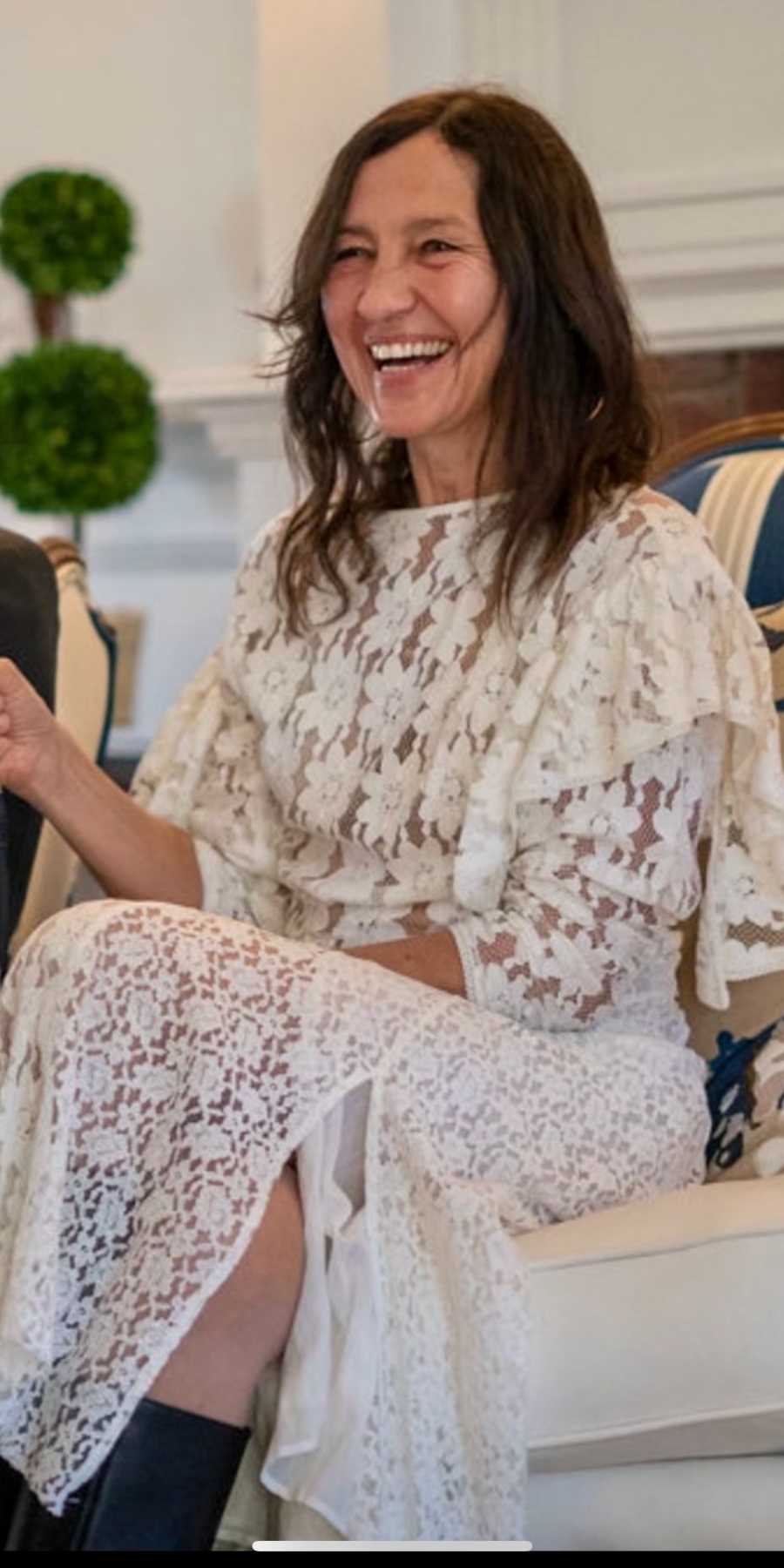
Below the Line: What type of historical research did you do to prepare for The Gilded Age?
Kasia Walicka-Maimone: The research was monumental. I have a phenomenal team and one of the members who I’ve worked with for about 16 years, Susana Gilboe, built this exquisite extraordinary historical library. It’s about 35,000 images of the costume archives that are documented, the art of the period, rules of dress, fashion plates, [and] magazines of the period. I think we had every visual image that is humanly possible in that library.
BTL: Did you also have to study the period where the series takes place?
Walicka-Maimone: When you start a new period, there’s always learning it. What pulls you out of the period, what resonates, and it’s sorting out. So it was studying the period and creating the design boards for each of the characters. They are driven by and deeply steeped in historical research. We knew the Gilded Age stands for opulence and the moment you start reading the history of the period, the extravagance of unlimited money and the giant discrepancies between new and old money, were to be portrayed in what they wore.
BTL: How much did the period impact your designs?
Walicka-Maimone: It was a tight collaboration with our director, Michael Engler, who was incredibly courageous in telling the story. He had a very clear vision of how he was going to tell it. In some ways, it was a modern approach to a very respectful period piece that is steeped in the period. It’s a fresh look at the period. We had to find a [visual] vocabulary of, ‘how do we appeal to the modern audiences within the period?’ It was a tricky balance.
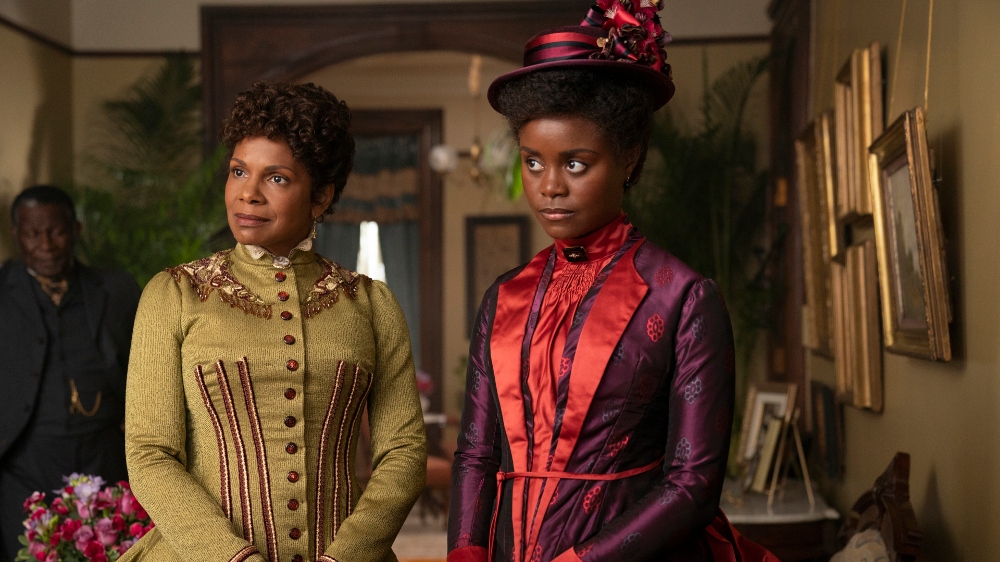
BTL: What did the clothes say about each character’s status?
Walicka-Maimone: Julian Fellowes gave such an incredibly rich history to each of the characters in the script. My job as a designer is to reflect those histories — where did they come from, what is their journey, what are they representing or manifesting, what are they hiding? Somehow it becomes the skin of the characters. So we are sorting out where they belong, which sphere they belong, how they are going to represent themselves, and their back histories, how they are going to co-exist with each other. The idea was that we needed to feel how those people felt.
BTL: For instance, Carrie Coon’s character, Bertha Russell, wanted to be accepted into the higher status of Agnes van Rhijn (Christine Baranski). How did that reflect what she wore?
Walicka-Maimone: Building Bertha’s and Agnes’ characters, there were two separate journeys. Bertha is trying to break into the society and impress the society and be one of them. She walked on a tightrope and I probably pushed it here and there. In creating the newness of Bertha and the old-establishment of Agnes, how do those ladies belong to the same world but clearly have different histories? The journey of Agnes was like visiting the Metropolitan Museum when you walk from room to room and discover the deep history, while building Bertha was like going to the Whitney Museum.
With Bertha, there is a newness I needed to discover without disrupting the order of the world that she is trying to belong to. For her I went after the French Parisian newest fashion plates of the period, the House of Worth which was an incredibly powerful house of fashion [that] was bringing in the new stuff of the time, which the old guard was also buying from but wouldn’t wear until the newness died down so they could feel provocative. It was a time where dyes were invented so I experimented much more with building clothes for Bertha that would incorporate those so she shows up in these incredibly bright yellows, flash sea-greenish dress.
BTL: How much did color play a part in the period?
Walicka-Maimone: I was kind of blown away by how much color was used. I had no idea that the period was loaded with color. The period provided so much inspiration [for] the brightness and the excitement of the color combinations. There are a lot of paintings from the period with lots of color. We were also lucky to find digitally documented garments from that period that are in great shape and well-preserved in color from museum archives. It was very helpful because we couldn’t physically go to the museums because everything was shut down. It was much more detailed because if you went to the MET and see them in person, you could only touch so much. We all experience colors as coded. We know that pale yellow means innocence and that deep maroons and blues on Agnes, the jewel tones mean royalty and tradition. Bertha’s journey through color is that red is power. It’s big and ostentatious in some ways, and at the same time, I tried to make it as feminine as possible.
BTL: What were the materials that you used to keep in sync with the period?
Walicka-Maimone: I used a lot of velvet for Agnes which we created. I couldn’t find a velvet that had two dimensions in it. I wanted to see two colors. If I found the two colors, the print was too modern and the textures were not right so we created it. For Agnes’ dress that you see in the poster, we put this yellow velvet underneath to create this goldness. The taffeta underneath is iridescent so in the light it changes colors. First, everybody was like, ‘are we out of our minds to do this?’ Once the gown was completed, it was worth the effort because it does show the dimension. Bertha wears silks and colors and we used a different symmetry and boldness of lines vs. a more traditional approach to fabrics.
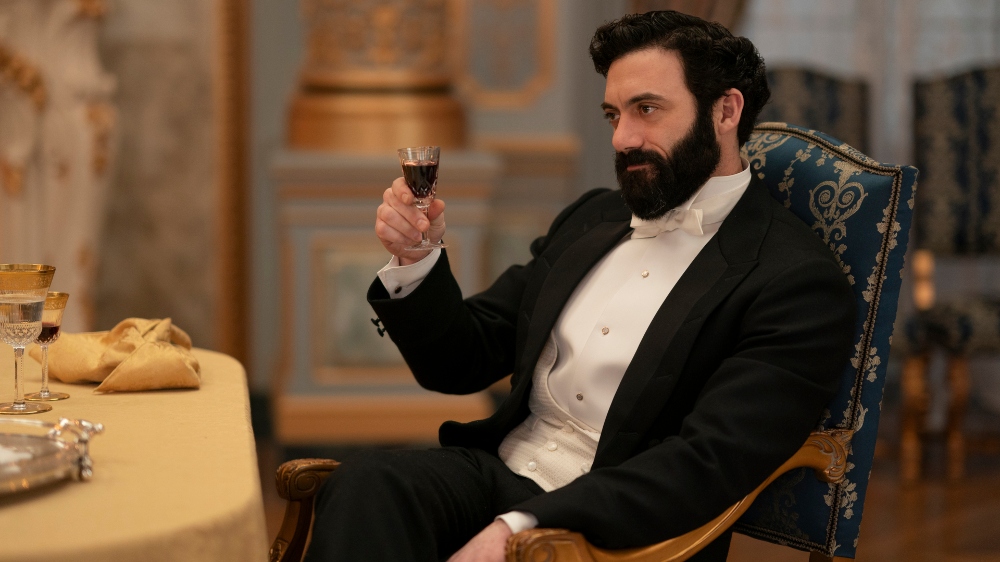
BTL: With all the entertaining going on and tea parties, how did that inform the costumes?
Walicka-Maimone: There was such a clear code of the dresses. There was the day walking dress, a tea dress, and the evening dress and then they changed for dinner and then for special events where people dressed up for the balls. I learned all those rules. It was endless extravagance. It was hard to comprehend how many times a day people changed!
BTL: What were you trying to achieve through the costumes?
Walicka-Maimone: We used about 5,000 costumes in the show which was very intimidating. If I thought about that, I probably would be too scared to do it [laughs]. The principals were all built in New York. Some of the men’s and the extras were built in Europe. We had to create a lot of the costumes because those stocks did not exist in rental houses. It was a massive operation. I have a phenomenal team of people and without the makers, we would see nothing. It was an incredible team of talented people that created this show. At some point, it was [about] embracing the extraordinary beauty, and I was fascinated to discover this world. If I can make people feel like they feel walking through let’s say the Newport Mansions and create the beauty and opulence of those characters. I was very proud of how we portrayed the world. I feel like I’ve done my job in giving a glimpse of what those worlds were in The Gilded Age.
Season 1 of The Gilded Age is now available on HBO and HBO Max.

